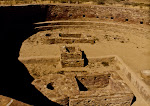
Canku Ota (Many Paths)
An Online Newsletter Celebrating Native America
June 1, 2002 - Issue 62
(Written January, 2002)
The Sculptures and Spirit of Allan Houser Haozous Displayed at the Olympics
by Suzanne Westerly, Photojournalist
also published in News From Indian Country
Phillip M. Haozous, standing next to the Sacred Rain Arrow statue, amongst the juniper, chamisa and sage of the Allan Houser Sculpture Garden located on the one hundred ten-acre Allan Houser Compound.
All photos copyright © 2002 of Suzanne Westerly
Sacred Rain Arrow - a young Apache warrior shooting his arrow towards the heavens with the hope of carrying a prayer for rain to the Spirit World.
During the Olympics, Allan Houser's Sacred Rain Arrow was displayed at the Salt Lake City and County Building where it welcomed athletes and officials from 80 countries. Phillip Haozous sculpted a Sacred Rain Arrow maquette. 300 in bronze are available for purchase.
Upon entering the 2002 Winter Olympics, athletes from all over the world were welcomed by the powerfully moving, larger-than-life bronze sculpture, Sacred Rain Arrow, created by one of the most important American artists of the 20th century, the internationally respected Master sculptor Allan Houser Haozous. A Warm Springs Chiricahua Apache, Allan Houser was very proud of his heritage, captivatingly portrayed in Sacred Rain Arrow, a sculpture of a young Apache warrior shooting his arrow towards the heavens with the hope of carrying a prayer for rain to the Spirit World.
Phillip M. Haozous, who accompanied his father's sculptures to the Olympics, is one five sons born to Allan and Anna Marie Houser. Phillip promotes his fathers legacy by sharing his art with the public at the Allan Houser Compound, a 110-acre area nestled in the sandy, softly rolling high desert dotted with juniper, near Santa Fe in New Mexico and speaking throughout the world. The Allan Houser Sculpture Garden was a collaborative project between Phillip and his father, each piece thoughtfully positioned in the beautiful open landscape with Santa Fe Mountains as a backdrop.
Besides bringing eighteen of his father's powerfully moving sculptures to the Olympics, Phillip felt the world should also know the very special man who created them by seeing his image amongst his monumental sculptures. Inspired by that thought, Phillip created a life-size bronze sculpture of his father titled, Allan Houser Haozous 1914-1994. With Phillips natural talent, he skillfully worked on the piece until it perfectly captured his father's personality. He knew it was finished when given a smile and nod of approval by his mother. The kind and warm demeanor emanating from Phillip can also be felt by looking in the eyes of the statue Phillip created of his father.
Raymond T. Grant, the artistic director of the 2002 Olympic Arts Festival said "Allan Houser is singularly one of those artists who embraced the three major elements of the mission of our Cultural Olympiad. Those elements are to highlight some of America's greatest contributions to the arts, to embrace the West and its cultures and to celebrate Utah and its heritage."
Allan Houser was an artist-in-residence and teacher at Utah's Inter-Mountain school in Brigham City, Utah from 1951-1962.
Allan Houser was born June 30, 1914 to Sam and Blossom Haozous. He was the first Warm Springs Apache baby born in freedom after 27 years of imprisonment, when the government finally released the Apaches after Geronimo's death.
Allan Houser's father, Sam Haozous, was an Apache warrior who fought for the freedom of his people alongside Geronimo (his uncle), Cochise, Naiche and Victorio. He was part of Geronimo's band who were taken prisoner when Geronimo surrendered (under conditions the government subsequently failed to honor), thus ending the "Indian wars."
Growing up working on the family farm near Apache, Oklahoma, Allan Houser's passion for art started with his drawings. His life as a respected artist began with his paintings, which he first exhibited in 1939 at the World's Fair in New York City. He then moved into a sculpting.
In 1962, the Houser family left Utah and settled in Santa Fe, New Mexico. There he was a teacher and then head of the sculpture department at the newly formed Institute of American Indian Arts until 1975.
Alan Houser reached into his childhood memories to create powerful and emotional portrayals of Native people, transforming his deep feelings into extraordinary pieces of art as illustrated in his life-size bronze, The Future (Chiricahua Apache Family). The Future was dedicated in 1983, honoring the memory of his parents and commemorating the 70th anniversary of the release of the Apache prisoners of war from Fort Sill. For over five decades, Allan Houser's sculptures of Native American themes, have depicted the pride and dignity of Native people. Later in his career, he created modern abstracts.
Alan Houser felt very strongly about human dignity for all people, which is clearly apparent in his sculptures.
The following images can be found by clicking HERE
Prayer Song
Prayer Song (close-up)
Lament
Lament (close-up)
He Will be Home Soon
Singing Heart
Pueblo Legacy
The Beginning
As Long As the Water's Flow
The Offering
Canku Ota is a copyright © 2000, 2001, 2002, 2003 of Vicki Lockard and Paul Barry.
The "Canku Ota - A Newsletter Celebrating Native America" web site and its design is the
Copyright © 1999, 2000, 2001, 2002, 2003 of Paul C. Barry.
All Rights Reserved.
Thank You


